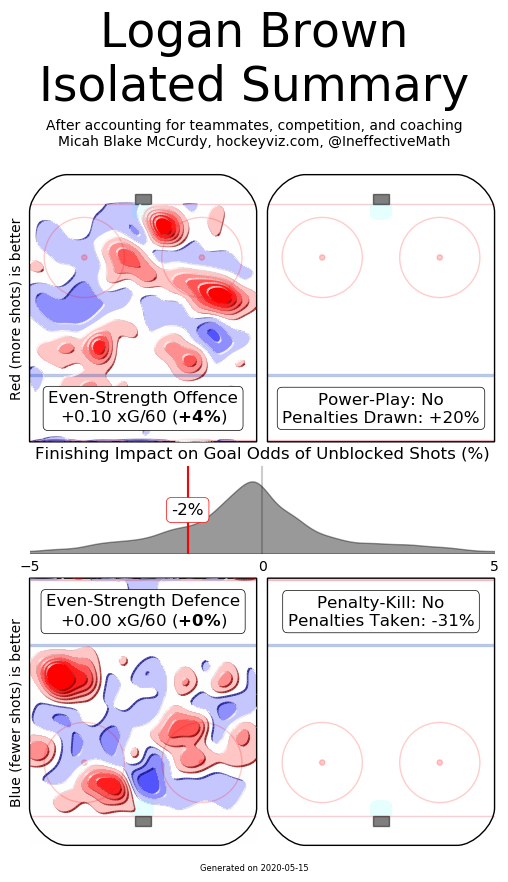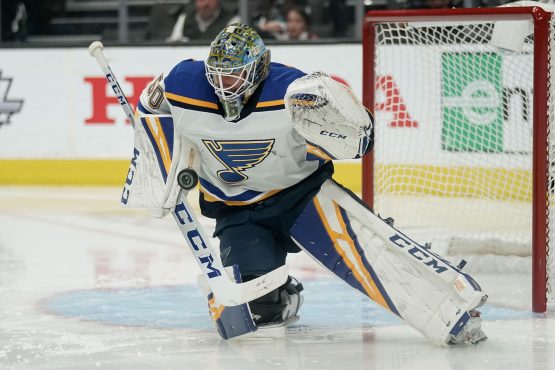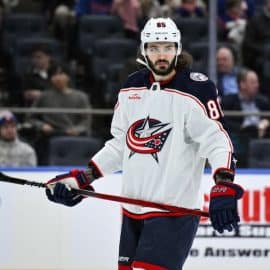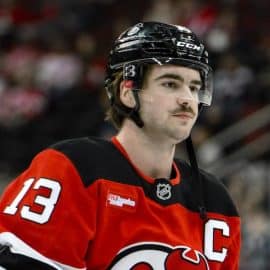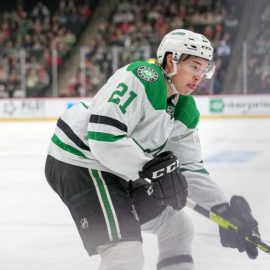When it comes to discussing the infusion of talent that the Senators will add using its two top-five selections and a combined seven picks through the first two rounds of this year’s NHL Draft, it is not hard to get excited about the Senators’ future.
Adding that kind of talent in a deep draft class alone would be exciting in itself, but in consideration of the fact that the Belleville Senators enjoyed some considerable regular season success and a few of Belleville’s forwards unanticipatedly flourished from an offensive perspective, the Senators are going to be injecting a lot of blue-chip talent into what’s already considered a deep and promising prospect pipeline.
As that depth grows however, there’s an unspoken understanding that not every prospect within the Senators’ ranks will play for the organization or fulfill their potential. And as newer and shinier prospects enter the mix, it is easy for others who have been with the organization for some time to be overshadowed.
Enter Logan Brown.
Although he was the Senators’ first round pick (11th overall) in 2016, it feels like he has been with the organization longer than that.
Of the 2016 first rounders, only nine picks have played in fewer career NHL games than Brown’s 29.
The lack of opportunity has been a sore spot for his representation. Last fall, Brown’s agent, Andy Scott, voiced his displeasure on TSN 1200 in regards to his client’s development path for the prospect.
“I can say with full confidence, that I’ve really never seen another player met with such resistance by the team that drafted them early in the first round,” said Scott, whose clients include Leon Draisaitl and Kappo Kakko. “From Day 1, I really have seen Logan have to grind and claw and work his tail off for every morsel of opportunity that he’s been provided. Whereas with some of these other guys, these elite players like Logan, it’s a little bit easier. They get paired with top lines, top players, put into positions to excel and case in point, you look at last season and he shows up and is on the eighth line, he’s the eighth-line centre. This is your 11th overall pick from the 2016 draft. He’s played no more than two games in all the years he’s been here playing with NHL wingers.
“It’s one of those situations where I think the prior coach in Guy Boucher for some reason or another, he never took a shine to Logan, but with the new coach D.J. Smith, I certainly think that’s a huge step in the right direction. This coach has a track record of really working with young players and getting the most out of them and I think he’ll be very, very good for Logan, very good for Ottawa. But, from 10,000 feet, when I look at this situation, I see a team that is in the throws of a rebuild and just driving around Ottawa you see the slogan for this season is ‘The Kids are Alright,’ and if the kids are alright, then play the kids. Why is Logan Brown not being groomed to be the next first or second-line centre?”
Brown’s development has been beset by injuries.
Since being drafted, Brown has only appeared in 177 games across three levels (OHL, AHL and the NHL) over the past four seasons.
Playing an average of 44.25 games per season is not going to help the development, but for last season was different for Brown. He not only averaged more than a point per game in the AHL (1.12), but he finally spent some considerable time in Ottawa – playing in more than a quarter of the team’s games (23).
Things actually started out well for Brown during his recall in late October. He tallied five points in his first nine games while averaging almost 15 minutes of ice time per game.
Although Brown’s production eventually faded, his stint with the Senators took a turn for the worst in the first two games of a short Western Conference road trip in late November and early December.
In these two games, both losses against the Minnesota Wild and the Vancouver Canucks, Brown played a combined 24:03 while finishing with a plus/minus rating of negative four. In his next game against Edmonton, Brown had 5:28 of ice time and played less than 10 minutes in five of his last 10 games before his demotion to Belleville.
Brown turned 22 years old this past March and in a league that has a tendency to graduate players — especially first round picks — to highest level quickly, it is easy to look at Brown’s development and age and come away with the sense that he should be further along in his development than he is.
The Senators already boast a complement of depth down the middle with players like Chris Tierney, Colin White, Filip Chlapik, and Nick Paul, but it was AHL ‘Rookie of the Year’ Josh Norris’ emergence as a potential middle-six centre that has left some prognosticators wondering if Brown will have an extended future with the Senators.
Even though Brown has more offensive potential than any of the players listed above, it does not help that projecting out, the Senators could wind up adding to more centres to their mix with two of their three first round selections in this year’s draft. It seems obvious that the Senators will attempt to address the first line centre position with a prospect like Quinton Byfield or Tim Stützle with their third overall selection.
Essentially this year’s draft could put the organization in a position to wonder whether Brown is more valuable to the organization as a trade chip than he is as a roster player.
Admittedly, I don’t know the player personally or his reputation within the team’s circles, so I can’t speak to things like character, work ethic, drive, coachability or how well he fits in with his teammates, but going back to his scouting reports in his draft year, Brown was dogged by concerns about things he could control like his physicality and effort.
Regardless of the knocks to Brown’s game, when I look at some of the numbers, it’s hard to ignore some signs that he could be a player who can help this organization on the ice. And in seeing how talented young players like Mika Zibanejad and Robin Lehner were moved in part because the organization had concerns about their work ethic and off-ice distractions, I would hate to see the organization part with another talented young player too soon.
According to NaturalStatTrick.com’s numbers of the Senators players who logged over 200 or more five-on-five minutes last season:
| CF% | FF% | SF% | GF% | SCF% |
| 49.15 | 50.78 | 51.09 | 55.00 | 54.85 |
When Brown was on the ice, the Senators largely outshot (CF%, FF%, SF%), outchanced (SCF%) and outscored (GF%) the opposition.
Although Brown only logged 219:30 of five-on-five ice time – an average of 9:32 of five-on-five ice time per game – the most impressive thing about Brown’s numbers are his goal rates.
| GF/60 | Rk | GF% | Rk | xGF/60 | Rk | xGF% | Rk |
| 3.01 | 1st | 55.00 | 2nd | 2.70 | 4th | 55.99 | 1st |
Brown’s five-on-five impact can also be seen visually through Micah Blake McCurdy’s exceptional work over at Hockeyviz.com.
From Micah’s graphic, we can see where the Senators generate chances from when Logan Brown is on the ice (note: red reflects an above average volume of shots and with blue, it’s the opposite). Looking at his offensive zone and defensive zone impacts at five-on-five, we see that Brown had an average impact in the defensive zone while providing a positive impact in the offensive end.
Brown is renowned for his playmaking skills and puck distribution, but his best attribute may very well be his puck protection skills. Even though Brown’s game has been knocked because he doesn’t necessarily have the nasty edge that people assume a 6’6”, 220 lb frame should have, Brown has mastered using his size and length to shield the puck from defenders and preserve the offensive cycle.
What is interesting in digging into Brown’s numbers is that a disproportionate volume of his shots were blocked last season.
Of the Senators forwards who logged over 200 minutes at five-on-five, only Vlad Namestnikov and Scott Sabourin had higher shots blocked per 60 minutes. Despite being a pass-first player, scouts have lauded Brown’s shot. If he played more selfishly and had a little bit better luck shooting through traffic, his point production could improve.
Although his foot speed and consistency have been knocked by scouts, Ottawa’s depth at the centre position could afford the team the luxury of moving Brown to the left wing.
The Senators obviously have Brady Tkachuk who can play in a top-six capacity for any NHL team, but beyond Tkachuk, the Senators don’t have much safely projectable top-six talent in their system. As much as I like Alex Formenton’s dynamic speed and enjoyed his breakout offensive season (27 goals, 53 points in 61 games) as a first-year pro in Belleville, most prognosticators believe that he most safely projects as a very good third-line winger.
In Scott Wheeler’s rankings of the Top 50 drafted NHL prospects (criteria — player must be: under 23 years of age; not currently playing in the NHL; signed or be selected in the entry draft without those rights expiring), he had this to say about the Senators’ omitted prospect:
“I’m still not convinced of Formenton as a top-six contributor (though he may be able to be the third best player on a line like that) but I’ve grown on his likelihood to have an offensive impact in a depth role, instead of being a utility guy who just forechecker and PKs.”
It would obviously be awesome if Formenton could exceed these expectations, but having young depth that can keep Formenton in that kind of third line role where he can thrive is only going to help Ottawa out down the line.
The question Pierre Dorion has to ask himself and his staff is how much the organization should invest in the belief that Anthony Duclair can be a long-term fit for the organization.
Back in April for The Athletic Ottawa, I discussed whether it was in the Senators’ best interests to move on from Anthony Duclair after the forward surpassed 40 points and set a new regular season high for goals with 23. Without getting too much into that piece, my argument was that despite Duclair’s offensive contributions, he was still a liability on the ice from a defensive-perspective and as such, it diminishes a lot of the value created by the things that Duclair does do well.
As a restricted free agent, this could be the perfect time to capitalize on Duclair’s bounce-back season and explore his trade value – hoping that some other organization overlooks his flaws and overvalues Duclair’s counting stats. If the Senators could package Duclair with some combination of prospects and picks to address a need like the blue line or move up in the NHL Draft, it could be advantageous, especially with a prospect like Logan Brown being a viable in-house candidate to replace a flawed player who put up good numbers on a bad team.
There is no question that as this team improves, eventually Duclair’s flaws will push him further down the lineup as the players around him improve.
Granted, the same sentiment could be used to explain why the Senators could explore trade packages involving Logan Brown to accomplish the same thing, but I believe that there are enough positive metrics and qualitative evidence to support the argument that he has more upside at this stage of his career than Duclair.
It is this kind of upside that the Senators need to explore, especially at a time when the team is in the midst of a rebuild and simply isn’t very good.
Add The Sports Daily to your Google News Feed!
